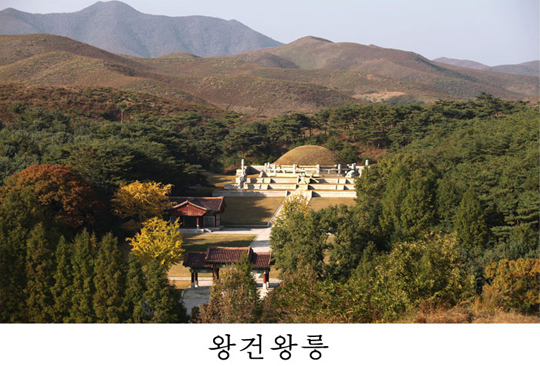Historic Monuments and Sites in Kaesong, the World Cultural Heritage properties
In June 2013, the World Heritage Committee at its 37th session inscribed 12 typical historic monuments and sites representing the history and culture of Koryo, the first unified state of the Korean nation, on the World Heritage List.
Those properties preserved in Kaesong with more than a thousand year urban history, enable to have a comprehensive and vivid picture of the development of Koryo.
Mausoleum of King Wang Kon, Seven Tombs Cluster, Myongrung Cluster and Mausoleum of King Kyonghyo
These are tombs of the representative kings and royal family members of the Koryo period built in the mountainous areas.
The Mausoleum of King Wang Kon which is the tomb of the founder king of Koryo is one of the valuable historic remains showing the long history and cultural traditions of the Korean nation.
It was rebuilt in 1994.
Seven Tombs Cluster is composed of seven tombs built in the middle and late period of Koryo, while Myongrung Cluster is composed of three tombs including the tomb of the 29th King Hyonhyo(Chungmok) that are presumed as dating back to 14th century.
The Mausoleum of King Kyonghyo is the tomb of the 31st King of Koryo and his Queen. It is the most outstanding stone-built structure in Korea in terms of size and architectural style and for its intactness.
Manwoldae
Situated at the foot of Mt. Songak, it is the site of the royal palace of Koryo.
In the forefront of the central group of buildings are four Great Staircases up to the 7.8m-high terrace, which clearly shows the majesty of the Koryo Royal Palace.
Koryo Songgyungwan
Koryo Songgyungwan was the highest educational institution of Koryo, similar to a present public university.
At that time, Songgyungwan mainly taught Confucian Scriptures together with politics, law, mathematics and calligraphy. Students were tens or hundreds in number. At present, more than ten buildings are divided into a lecture-hall compound, a shrine compound and an auxiliary compound. To the west of it, there are pagodas, steles, stone lanterns and stupas of the Koryo period.
Kaesong Walls and Kaesong Namdae Gate
Kaesong Walls were the city walls in the form of plain and mountain walls linking high and low mountains and hills around the city.
Kaesong Walls are composed of the Imperial Wall, Palace Wall, Outer Wall and Inner Wall which were built at different years.
Kaesong Namdae Gate, the south gate of Inner Wall, is now situated in the middle of the crossroad in the central part of Kaesong. This gate, the symbol of Kaesong, was burnt by bombing during the Fatherland Liberation War and was restored to its original state after it. Hanging on the pavilion now is the bell from the Yonbok Temple, one of the five major bells in Korea.
Kaesong Chomsongdae
Kaesong Chomsongdae was an astronomical meteorological observatory to the west of Manwoldae, and only its platform remains. From the records in Koryosa, it can be assumed that Chomsongdae was used for surveying the movement of the celestial bodies and the peculiar natural phenomena and also for telling the time, measuring precipitation and forecasting the weather.
Sungyang Confucian Shrine
Originally, it had been a house owned by Jong Mong Ju but it was converted and used as a private Confucian educational institution since the latter half of the 16th century. It is one of the early Confucian institutions in our country.
Sonjuk Bridge and Phyochung Monuments
Sonjuk Bridge is a small stone bridge which was originally called Sonji Bridge.
Jong Mong Ju was murdered by Ri Song Gye’s cohorts for being loyal to Koryo dynasty. Legend has it that later a bamboo began to grow at the site of his death. From that time, the bridge began to be called Sonjuk Bridge.
Phyochung Monuments were built in praise of Jong Mong Ju's loyalty in the period of the feudal Joson dynasty and two monuments are housed in a pavilion. Each of the monuments consists of a turtle-shaped plinth, a black marble body and a roof-shaped head with dragon engraving. The Monuments show the high skills of masonry of those times.
